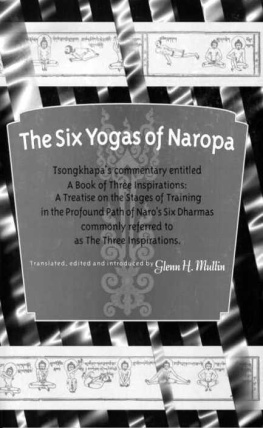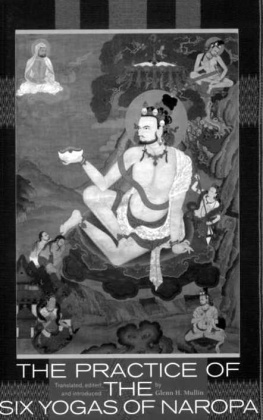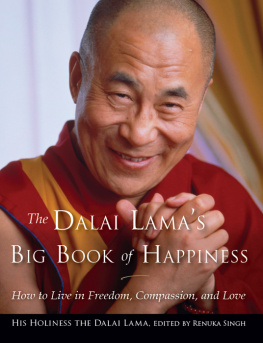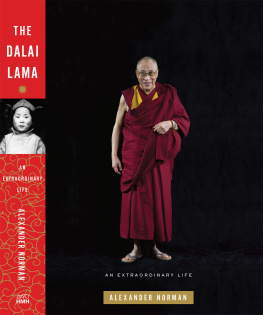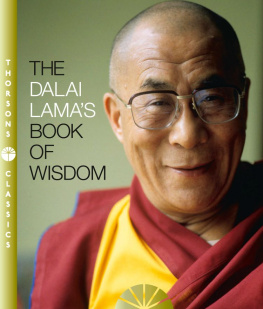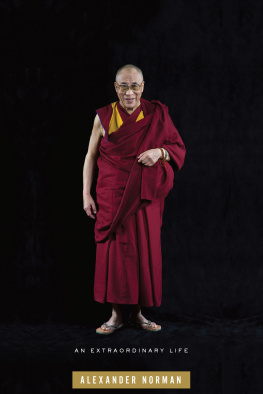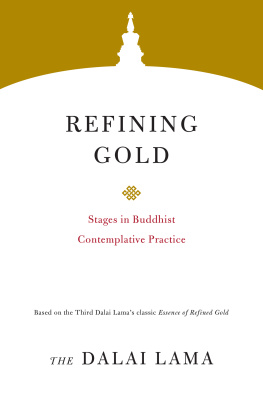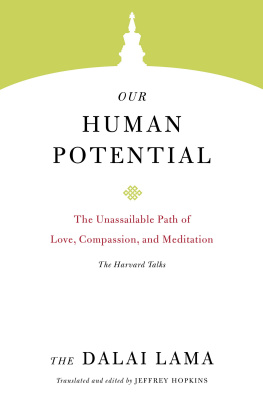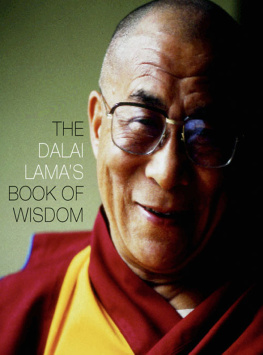THE FOURTEEN
DALAI LAMAS
A Sacred Legacy of Reincarnation
Glenn H. Mullin
Edited by Valerie Shepherd FOREWORD BY
His Holiness the Dalai Lama
CLEAR LIGHT PUBLISHERS SANTA FE, NEW MEXICO
Dedicated to the memory of my two principal tantric gurus: Kyabjey Ling Dorjechang and
Kyabjey Trijang Dorjechang
Copyright 2001 Glenn H. Mullin
Clear Light Publishers
823 Don Diego
Santa Fe, New Mexico 87501
web site: www.clearlightbooks.com
All rights reserved. No part of this book may be reproduced or transmitted in any form or by any means, electronic or mechanical, including photocopying and recording, or by any information storage or retrieval system, without permission in writing from the publisher.
First Edition
10 987654321
Cover photographs by Marcia Keegan Design by Marcia Keegan and Carol OShea Typography by Carol OShea Printed in Canada
Library of Congress Cataloging-in-Publication Data
Mullin, Glenn H.
The fourteen Dalai Lamas : a sacred legacy of reincarnation /
Glenn H. Mullin; edited by Valerie Shepherd; foreword by His Holiness the 14th Dalai Lama, p. cm.
isbn 1-57416-039-7
1. Dalai LamasBiography. I. Shepherd, Valerie M. II. Title
BQ7930.M84200 294-3 923 0922dc2i [B]
99-044923
Acknowledgments
This book is the product of many years of involvement with Tibets spiritual culture. This began with informal reading and study as a young man, and then culminated in my traveling to Himalayan India in 1972 and remaining there in formal Buddhist training for a period of twelve years, first at the Buddhist Studies Department of the Library of Tibetan Works and Archives, and then at the Tibetan School of Dialectical Studies. During this period I had the honor and privilege of receiving teachings, initiations and transmissions from some thirty-five masters from the various schools of Tibetan Buddhism. Foremost amongst these were Kyabjey Ling Dorjechang and Kyabjey Trijang Dorjechang, the two principal gurus of His Holiness the Dalai Lama. These two masters were grandfatherly figures in my life, embodying all things good in Tibetan culture and in Buddhism, as well as every noble quality of the human spirit. Their passing in the early 1980s left a void that can never be filled. The present volume is therefore dedicated to their memory.
Over the past two decades I have written approximately a dozen books on the lives and teachings of the various Dalai Lamas. Most of these were published by Snow Lion in Ithaca, New York. I would like to thank Jeff Cox and Sidney Piburn, my two old friends and editors at Snow Lion, for their permission to incorporate a few materials from those many books here.
The many years that I spent pouring over Tibetan manuscripts during my studies in Himalayan India involved the guidance of Tibetan mentors and friends too numerous to list in full. Nonetheless the most important of them should be mentioned here. Three of these were incarnate lamas: H.E. Doboom Tulku, H.E. Amchok Tulku, and H.E. Sharpa Tulku. Some were learned monks carrying the geshey degree, such as Geshey Ngawang Dargyey, Chomdzey Tashi Wangyal, Geshey Tubten Tsering, and Geshey Tenpai Gyaltsen. Others were lay scholars, including Lobzang Norbu Tsonawa, Tsepak Rigzin, Lobsang Dawa, Tubten Jampa and Lobzang Chompel.
More recently during the immediate preparation of this book two Tibetan lamas showed special kindness to me, offering guidance, advice and technical assistance: Geshey Lobzang Tenzin Negi, Ph.D., and Geshey Yeshey Pelgyey. The former is the director of the Loseling Institute in Atlanta, which is an affiliate of Emory University, and has been a very dear friend for many years. The latter manages Tibetan Traditions in Atlanta, and consults on the interests of Drepung Loseling Monastery in America. Geshey Yeshey Pelgyey in particular was especially considerate, helping me with the biographies of the Fourth, Fifth and Sixth Dalai Lamas.
Geshey Drakpa Kelsang contributed to the chapter on the Ninth to Twelfth Dalai Lamas, all of whom were short-lived.
I would very much like to thank my editor, Valerie Shepherd, as well as Harmon Houghton, Marcia Keegan and the staff of Clear Light Publishers for their patience and perseverance on this project. The book was over a year in the making and required considerable teamwork. (I prefer to think of my writing temperament as a passion and a virtue, but nonetheless it requires the indulgence of my editors.)
Finally, my deepest gratitude goes to my wife, Debby, for her emotional and intellectual support and inspiration; and to my seven children for their many lessons in humor and laughter.
It is not possible for one individual in the present era of the kaliyuga to write a book of this nature and scope without a number of errors creeping onto the pages. The story has a cast of thousands, and continues over many centuries. I have done my best to keep on track, but occasionally may have lost my focus. Therefore in advance I would like to thank the buddhas, bod-hisattvas, dakas, dakinis and Dharma protectors for overlooking any mistakes that have occurred. My hope is that whatever I have gotten right will more than make up for wherever I have gotten wrong.
Table of Contents
Chronological Table
First Dalai Lama | Gyalwa Gendun Drubpa 1391-1474/5 |
Second Dalai Lama | Gyalwa Gendun Gyatso 1475-1542 |
Third Dalai Lama | Gyalwa Sonam Gyatso 1543-1588 |
Fourth Dalai Lama | Gyalwa Yonten Gyatso 1589-1617 |
Fifth Dalai Lama | Gyalwa Ngawang Lobzang Gyatso 1617-1682 |
Sixth Dalai Lama | Gyalwa Tsangyang Gyatso 1683-1706 |
Seventh Dalai Lama | Gyalwa Kalzang Gyatso 1708-1757 |
Eighth Dalai Lama | Gyalwa Jampel Gyatso 1758-1804 |
Ninth Dalai Lama | Gyalwa Lungtok Gyatso 1805 / 6-1815 |
Tenth Dalai Lama | Gyalwa Tsultrim Gyatso 1816-1837 |
Eleventh Dalai Lama | Gyalwa Khedrub Gyatso 1838-1855/6 |
Twelfth Dalai Lama | Gyalwa Trinley Gyatso 1856-1875 |
Thirteenth Dalai Lama | Gyalwa Tubten Gyatso 1876-1933 |
Fourteenth Dalai Lama | Gyalwa Tenzin Gyatso July 6,1935 |
Foreword
His Holiness the Dalai Fama
In recent years, steadily growing awareness of Tibet and its rich and ancient culture has sparked interest in the successive lineage of the Dalai Lamas as an institution. This is, I am sure, a result of the closely entwined relationship that has historically existed between Tibet, its people and the Dalai Lamas.
Seventh-century Tibet was a militarily powerful nation, unified under a single ruler, whose influence was felt far and wide. King Songtsen Gampo was the first of three religious kings whose efforts resulted in a complete change in the Tibetan outlook. They introduced Buddhism from India with the effect of shifting the focus of conquest from neighbouring peoples and lands to the inner workings of the mind and heart. In the ensuing centuries, as the Buddhist way of life, with its rich art and literature, was steadily assimilated, the Tibetan nation became politically fragmented.
Next page

